Category: Q&A — Published:
We commissioned London-based artist and choreographer Joe Moran to create a new dance work to coincide with Carlos Bunga’s current exhibition, Something Necessary and Useful. The project Materiality will be Rethought navigates dance’s potential to disrupt architectural space and offers a new framework from which to experience Bunga’s installation. In turn, the sculptural environment enables the dancers to explore the boundaries between body and space.
Though the work has not yet been staged publicly, we held a dress rehearsal of the first performance just before the Gallery’s closure, photographed by Camilla Greenwell. The below Q&A with Jane Scarth, Whitechapel Gallery Curator: Public Programmes, offers insight into Moran’s inspirations, research and collaborative spirit to whet your appetite before the future live performance.
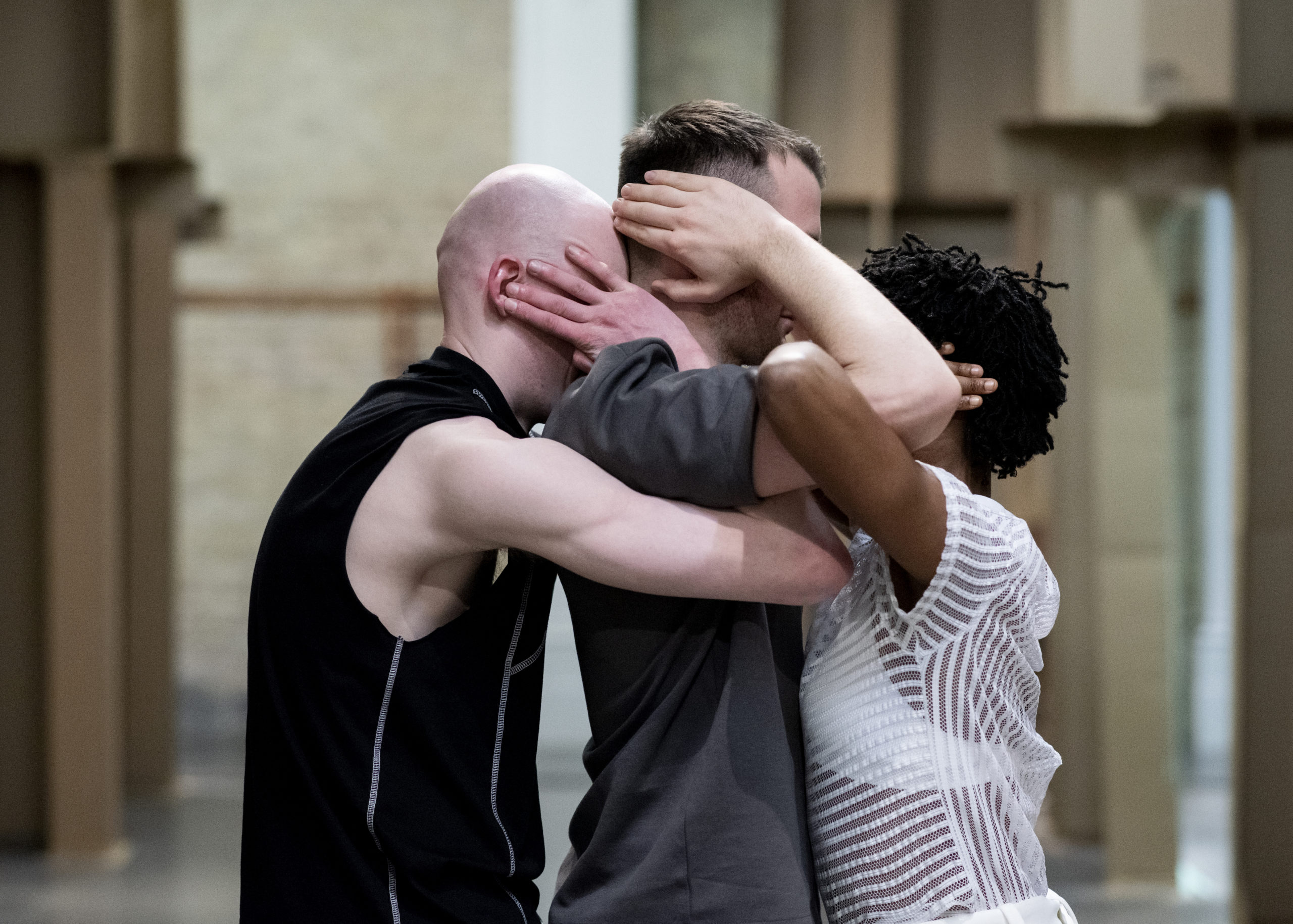 Materiality Will Be Rethought by Joe Moran presented in the exhibition Something Necessary and Useful by Carlos Bunga. Commissioned by Whitechapel Gallery and produced by Dance Art Foundation. Dancers: Temitope Ajose-Cutting, Thomas Heyes and Sean Murray. Photography: Camilla Greenwell.
Materiality Will Be Rethought by Joe Moran presented in the exhibition Something Necessary and Useful by Carlos Bunga. Commissioned by Whitechapel Gallery and produced by Dance Art Foundation. Dancers: Temitope Ajose-Cutting, Thomas Heyes and Sean Murray. Photography: Camilla Greenwell.
Can you tell me about the title, Materiality will be Rethought, and what it is intended to evoke?
In 2011, I created an artist book called Text for Score for Performance where I invited a range of artists and researchers to share a short text – from theoretical and philosophical writing or prose and poetic works – that might operate as a score for creating performance. I made a work at the time that drew upon a number of the 43 texts and intended that the book could be a kind of open source tool for making. In framing the texts as scores, I felt able to engage with them in a more mobile, textural or compositional way: exploring their rhythms, images, associations, implications. Moving with the text or making from it could offer multiple ways to arrive at meaning. I returned to the book last summer having become interested in working with texts again, specifically to use voice and shouting from a choreographic perspective. The contribution by queer scholar Paul Halferty stood out for me:
‘In this sense, what constitutes the fixity of the body, its contours, its movements, will be fully material, but materiality will be rethought as the effect of power, as power’s most productive effect. And there will be no way to understand ‘gender’ as a cultural construct which is imposed upon the surface of matter, understood either as ‘the body’ or its given sex. Rather, once ‘sex’ itself is understood in its normativity, the materiality of the body will not be thinkable apart from the materialization of that regulatory norm. ‘Sex’ is, thus, not simply what one has, or a static description of what one is: it will be one of the norms by which the ‘one’ becomes viable at all, that which qualifies a body for life within the domain of cultural intelligibility’ – Judith Butler
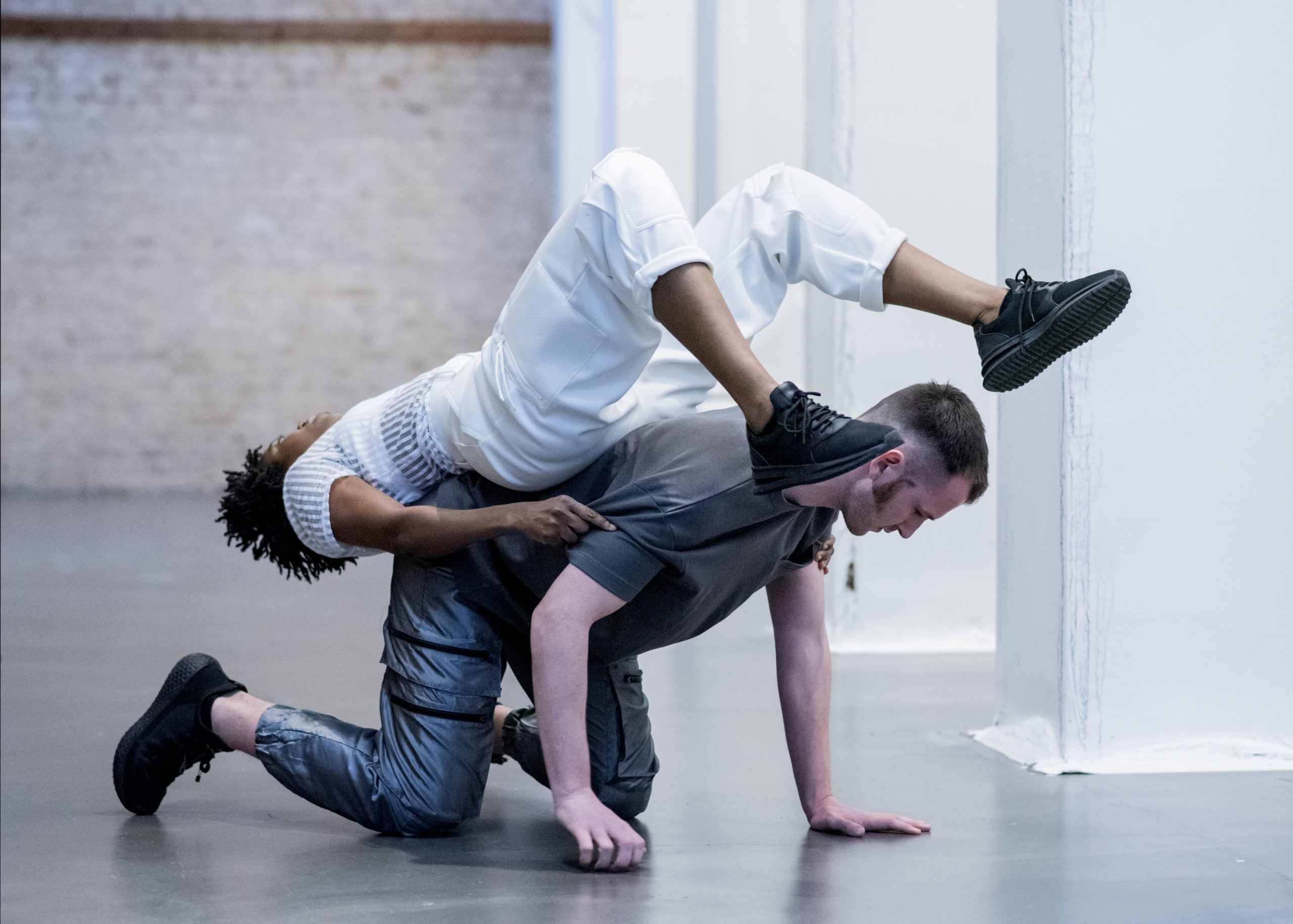 Materiality Will Be Rethought by Joe Moran presented in the exhibition Something Necessary and Useful by Carlos Bunga. Commissioned by Whitechapel Gallery and produced by Dance Art Foundation. Dancers: Temitope Ajose-Cutting, Thomas Heyes and Sean Murray. Photography: Camilla Greenwell.
Materiality Will Be Rethought by Joe Moran presented in the exhibition Something Necessary and Useful by Carlos Bunga. Commissioned by Whitechapel Gallery and produced by Dance Art Foundation. Dancers: Temitope Ajose-Cutting, Thomas Heyes and Sean Murray. Photography: Camilla Greenwell.
Returning to the texts nearly 10 years later has been exciting and I felt this extract spoke to many of the concerns now at play in my work. I deeply appreciated the notion of the unfixity of the body and of gender, and potentiality of rethinking regulatory norms.
The text evokes much of what I find remarkable about dance: what I would describe as making multiplicity tangible. If we concede that we cannot represent that which exists outside representation, I think that dance and the act of dancing is a means by which we can implicate that outside, another state or site; to conflate elements so that they confuse and flicker to bring present that which cannot be represented. In my practice, I frequently work with a notion of complicating the dancer’s subjectivity, by inviting them to play with multiple awarenesses, perceptual puzzles and confounding tasks, or disrupting how we see the body, in order to unsettle the fixity of presence.
The dancer is of course always inscribed by her history, her race, gender, culture, context. Yet, in the act of dancing she can multiply as an actual person, an idea, an abstraction, a proposition, a character, a state of being, an emotion, a voice, an image, a question, an approximation, a transmutable force of energy. I do not mean this in any metaphorical or representational sense, but in a lived sense where it may be witnessed in dancing. I relish when the dancer occupies a state of expanded perceptual, sensory and embodied awareness. A liminal and comprehensive state where one can witness a power of being in tension with and immersed both our material constraints and beyond them; witnessing both where one is and where one is not. The dancer of course inevitably reconstitutes from any expanded or complicating state. Yet, I wonder if it is precisely in this tension that dance may speak to the political – the tension between my lived experience that I am always already choreographed by history, culture and politics and that in dancing the fixity of representation may also be dislodged and made mobile.
The title Materiality Will Be Rethought is taken from an extract of a text from Judith Butler’s book Bodies that Matter: Discursive Limits of Sex. How it speaks to the body, to the radical act of rethinking and to discourses of power felt entirely fitting with the concerns of the work.
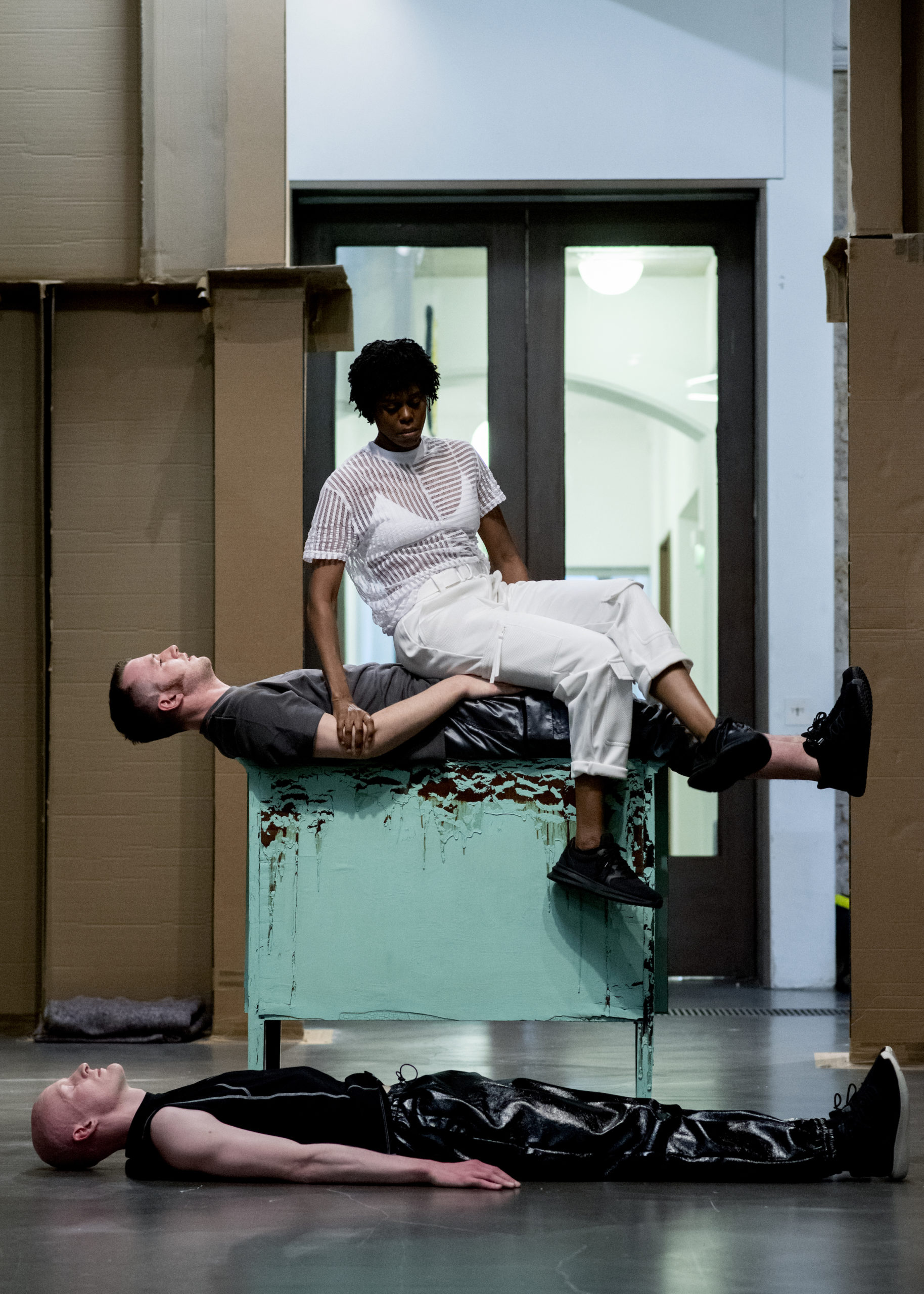 Materiality Will Be Rethought by Joe Moran presented in the exhibition Something Necessary and Useful by Carlos Bunga. Commissioned by Whitechapel Gallery and produced by Dance Art Foundation. Dancers: Temitope Ajose-Cutting, Thomas Heyes and Sean Murray. Photography: Camilla Greenwell.
Materiality Will Be Rethought by Joe Moran presented in the exhibition Something Necessary and Useful by Carlos Bunga. Commissioned by Whitechapel Gallery and produced by Dance Art Foundation. Dancers: Temitope Ajose-Cutting, Thomas Heyes and Sean Murray. Photography: Camilla Greenwell.
I’m interested to know how you found the process of making work designed to be in coexistence with that of another artist. There were quite unique synergies between your approaches and interests and those of Carlos Bunga.
The process of being invited to undertake the commission involved meeting and talking with Carlos and the curatorial team at Whitechapel. Through these conversations, it was apparent that there are some central meeting points between our practices. I think Carlos’ work shares my interest in the fertile spirit of complication, conflation and multiple or even conflicting meanings occurring simultaneously; for example, in how he uses paint to make household furniture unfamiliar in ways that brings into focus and yet simultaneously removes their functionality. Carlos had a clear intention for dancers to populate the exhibition which is something that is increasing prevalent in his work. I understand this arises from his strong interest in architectural space and its implication of the body. In general, the implication of the body and choreographing of the viewer’s body is something I find so strongly present in sculpture and in how it operates, which for me engenders an immediate shared language between sculpture and dance.
Being commissioned to create a work within the exhibition proved to be a very rich experience. I spent quite a few days in the exhibition before it opened, whilst Carlos and his team were still making and installing, to begin to understand its terms and to explore how a dance work could coexist with the installation. In this way, I approached the commission as a site-specific work, intending to speak to and to be in dialogue with the context, but also not to be swallowed up by it or subservient. These concerns inevitably speak to the tensions of dance in the gallery and its historical relationship to the visual arts that I was invited to write about for an essay included in the exhibition catalogue.
The prominence of architectural concerns in the exhibition and of the exhibition space itself quickly revealed themselves to be quite seductive given that dance lends itself readily to the animation of architecture. When the dancer holds architectural space in their awareness, moving with and in relation to it, a reframing of a site can occur where the dancer becomes a human-scale way in to considering our relationship to our environment. It can have a simple, powerful eloquence that is compelling and satisfying. This kind of complicity is also present with dance and sculpture that raises a critical issue: the challenge of achieving an active dialogue between the two forms, rather than sculpture operating as a set or backdrop for dance, or dance being an adornment or animation of sculpture. So, it was very much at the forefront of my mind that, whilst dance responding to architecture or sculpture is captivating, it is also grossly limiting of dance as an artform, and dance needs to do more to hold its own.
 Materiality Will Be Rethought by Joe Moran presented in the exhibition Something Necessary and Useful by Carlos Bunga. Commissioned by Whitechapel Gallery and produced by Dance Art Foundation. Dancers: Temitope Ajose-Cutting, Thomas Heyes and Sean Murray. Photography: Camilla Greenwell.
Materiality Will Be Rethought by Joe Moran presented in the exhibition Something Necessary and Useful by Carlos Bunga. Commissioned by Whitechapel Gallery and produced by Dance Art Foundation. Dancers: Temitope Ajose-Cutting, Thomas Heyes and Sean Murray. Photography: Camilla Greenwell.
You developed your use of the dancer’s voice in a new way for this work. There are a few moments in the piece where the dancers are shouting – at each other, into the wall cavity, and through a blanket. I’m curious to know more about how this engagement with the embodied voice has evolved for you?
I have worked with text and voice before, such as dancers being in simple direct address or conversation with audiences but, as you mention, for this work I wanted to explore physicality of the voice. Much of my work has been concerned with the notion of choreography as an expanded practice, or expanded choreography, which might be described as choreographic thinking or inquiry, explored in mediums beyond dance or not necessarily wed to dance, dancing or moving bodies. This proposition suggests choreography comprises strategies that may find form in writing, drawing, publication, theory, instruction, propositions, politics, care, sculpture, social interaction, movement of peoples, protest – the list goes on, or more simply, it addresses the choreographic as a form, subject and discipline that may be distinct from dance and dancing.
This inquiry aligns to what has been described as ‘conceptual dance’, a movement that emerged in Europe and the US in the 1990s and has most extensively been discussed by dance theorist Andre Lepecki in his book Exhausting Dance. ‘Conceptual dance’ as a term is greatly contested and indeed rejected many of the artists who are associated with it, but it does brings into focus the very helpful idea that, as Lepecki says, ‘the isomorphic relationship between dance and movement’ can be disrupted, opening the field for expanded or expanding understandings of choreography. My approach to voice is in this spirit. Thinking about how text might have a physical life in the voice of the performer and can be shaped, organised and composed without immediate recourse to the text’s linguistic meaning. Wendy Houston, a choreographer and performer who worked frequently with DV8 and Forced Entertainment but is perhaps most well known for her extraordinary solo works, is I think a particular pioneer in the UK of a choreographic approach to voice and text.
Beyond exploring its physicality, voice is also deployed to give a sense of weight and substance to the work in the spirit of it holding its own within the exhibition. I think some contemporary dance in gallery contexts is at risk of coming across as a bit limp, particularly more nuanced and detailed work, and I wanted to present something that grabbed an audience with a potency and strength. Whilst inviting the dancer to speak or shout does not necessarily equate to the dancer having agency or autonomy, such as in terms of the working process or labour conditions for example, the voice and shouting also serves as a device to approximate the agency and power of a performer, in this work refuting the spectre of the voiceless silenced dancer.
I also think there is a huge amount to shout about at the moment.
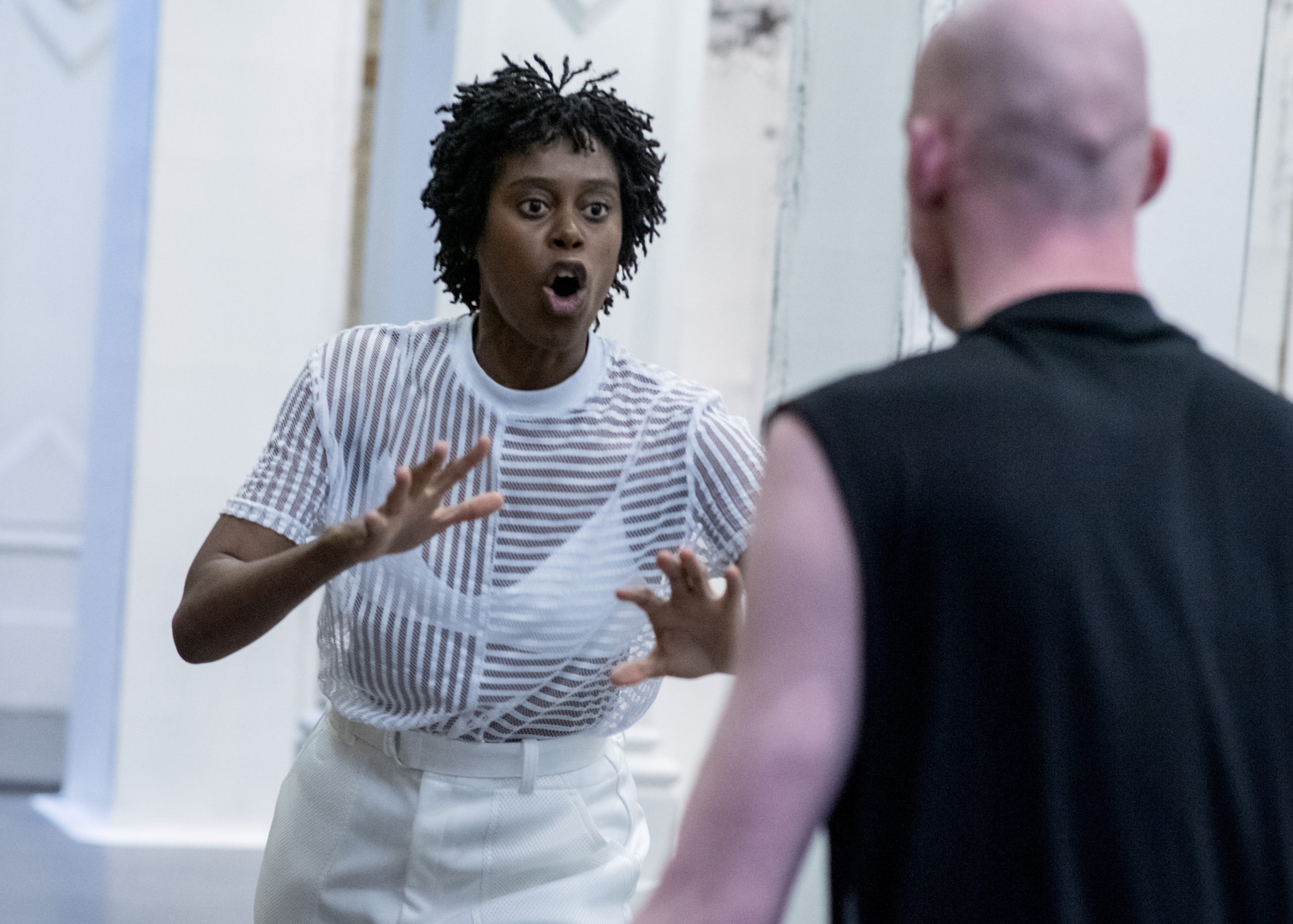 Materiality Will Be Rethought by Joe Moran presented in the exhibition Something Necessary and Useful by Carlos Bunga. Commissioned by Whitechapel Gallery and produced by Dance Art Foundation. Dancers: Temitope Ajose-Cutting, Thomas Heyes and Sean Murray. Photography: Camilla Greenwell.
Materiality Will Be Rethought by Joe Moran presented in the exhibition Something Necessary and Useful by Carlos Bunga. Commissioned by Whitechapel Gallery and produced by Dance Art Foundation. Dancers: Temitope Ajose-Cutting, Thomas Heyes and Sean Murray. Photography: Camilla Greenwell.
Could you tell me a bit about how the idea of ‘the moving body as a site of political unrest’ plays out in this work, and how that might have developed in part two?
The body is acutely political in that it is replete with the complexities of identity, representation, objectification and inequity. This is perhaps more intensely so for the body in performance, given the audiences’ gaze and the scrutiny afforded by the frame, and in turn I would suggest that the moving body points to an even greater degree of exposure. Much contemporary and postmodern dance has done this reality a great disservice by laboring under an essentialist fantasy of a neutral or de-politicised body, impervious to postcolonial critique that the person is always already mediated and constructed by their culture, history, education, training, opportunity, discourse and recourse to knowledge and privilege. When I wrote the description of ‘the moving body as a site of political unrest’ I had been thinking in part about Ta-Nehisi Coates’ writing on racism and how being invited to share his views on white supremacist culture is actually asking him ‘what it meant to lose his body’; that racism is experienced on and in the body of people of colour in violence and experiences of disembodiment.
I was also reflecting about how the traumas of misogyny, homophobia, transphobia and ableism are deeply embodied experiences felt and held in the body. I recently had a window on to the physical impact of structural violence through an instance of institutionalised homophobia. This is not a daily experience for me as it is for many, due to my many privileges as a white, university educated, able bodied, cis male. None the less, it did help me to make sense of some of my past experience in light of what I have read more recently and heard from friends and colleagues about what can be the daily experience of embodied trauma resulting from systemic violence. My cognitive understanding and attempts to unpick the different elements at play had no bearing on the profound physical impact and dislocation that I can only describe as a feeling of having been run over by a truck. So, it is in this sense that I have been thinking of the body as the site of the political, and was interested to read this echoed in an article by Paul B. Preciado this morning on the Coronavirus pandemic and the work of critical theorist Michel Foucault. Preciado reflects, ‘The most important thing we learned from Foucault is that the living (therefore mortal) body is the central object of all politics. There are no politics that are not body politics. But for Foucault, the body is not first a given biological organism on which power then acts. The very task of political action is to fabricate a body, to put it to work, to define its modes of production and reproduction, to foreshadow the modes of discourse by which that body is fictionalized to itself until it is able to say “I”.’
 Materiality Will Be Rethought by Joe Moran presented in the exhibition Something Necessary and Useful by Carlos Bunga. Commissioned by Whitechapel Gallery and produced by Dance Art Foundation. Dancers: Temitope Ajose-Cutting, Thomas Heyes and Sean Murray. Photography: Camilla Greenwell.
Materiality Will Be Rethought by Joe Moran presented in the exhibition Something Necessary and Useful by Carlos Bunga. Commissioned by Whitechapel Gallery and produced by Dance Art Foundation. Dancers: Temitope Ajose-Cutting, Thomas Heyes and Sean Murray. Photography: Camilla Greenwell.
In the performance, these ideas are explicitly present in the use of texts from The Coming Insurrection, an anarchic polemic by the anonymous collective The Invisible Committee, aggressively refuting neoliberal individualisation and its fusion with regimes of control: ‘Mass personalization. Individualization of all conditions – life, work and misery. Diffuse schizophrenia. Rampant depression. Atomisation into fine paranoiac particles. Hysterisation of contact. The more I want to be me, the more I feel an emptiness. The more I express myself, the more I am drained. The more I run after myself, the more tired I get. We cling to our self like a coveted job title. We’ve become our own representatives in a strange commerce, guarantors of a personalisation that feels, in the end, a lot more like an amputation. We insure ourselves to the point of bankruptcy, with a more or less disguised clumsiness’. A bleak world view perhaps but one that I found liberating and energising to hear shouted out loud.
I also wanted to speak to these concerns in how the body of the dancers appears in the work. As I touched upon above, I question whether the limitation and oppression of regulatory systems can be addressed on their own terms. In complicating the configuration and arrangement of bodies in the work and placing the dancers on an edge that teeters unclearly between humour, violence and cooperation, I have wanted to open a space of multiplicity that might helpfully dislodge, disrupt and collapse notions of what and how a person, body or indeed performance should be.
How this may have developed in part two of the commission remains unknown but this is something that my collaborators and I may discover as we explore the potential of reimagining the work for it to be shared within the confines and limitations of social distancing. This would be an entirely new frame.
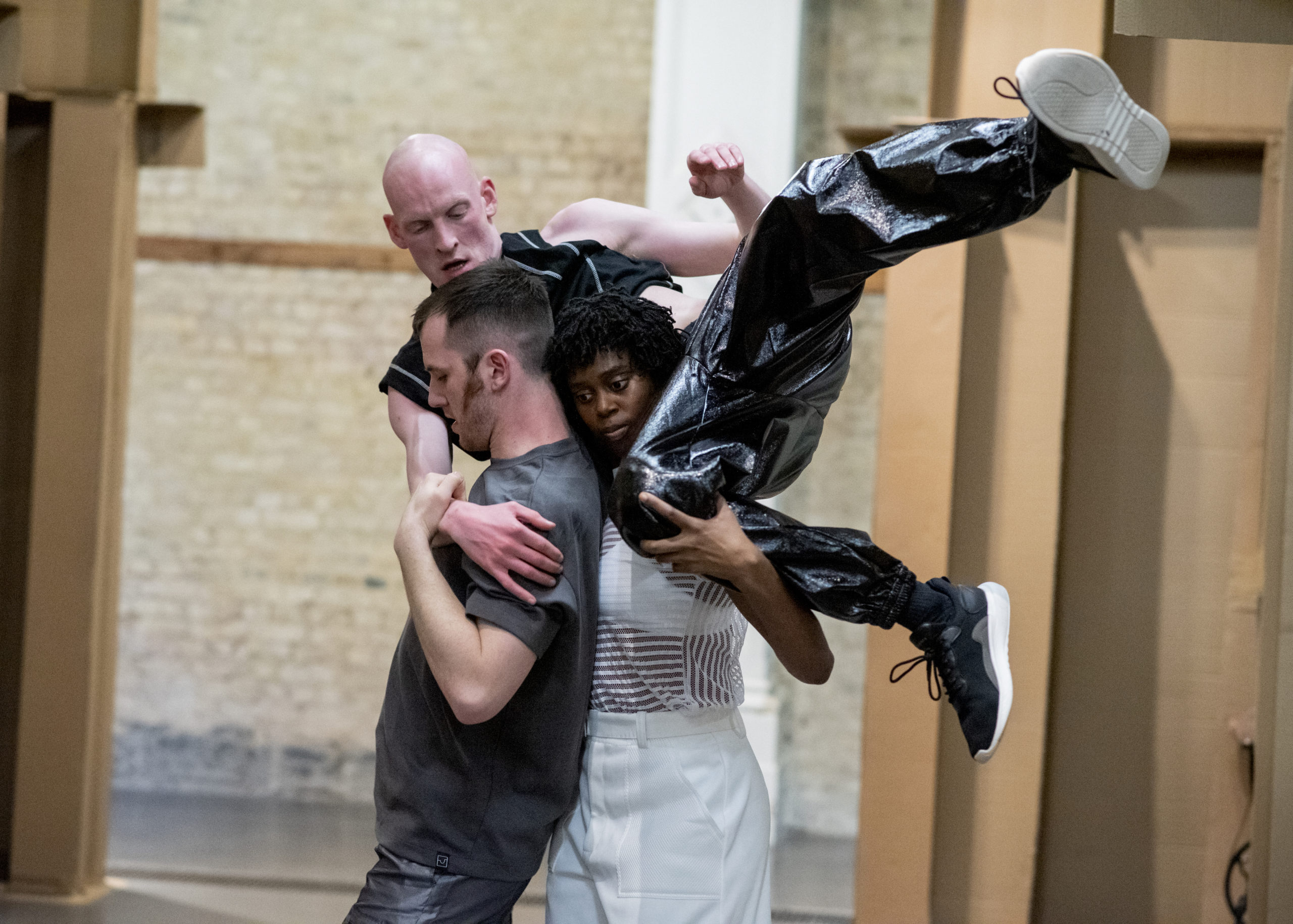 Materiality Will Be Rethought by Joe Moran presented in the exhibition Something Necessary and Useful by Carlos Bunga. Commissioned by Whitechapel Gallery and produced by Dance Art Foundation. Dancers: Temitope Ajose-Cutting, Thomas Heyes and Sean Murray. Photography: Camilla Greenwell.
Materiality Will Be Rethought by Joe Moran presented in the exhibition Something Necessary and Useful by Carlos Bunga. Commissioned by Whitechapel Gallery and produced by Dance Art Foundation. Dancers: Temitope Ajose-Cutting, Thomas Heyes and Sean Murray. Photography: Camilla Greenwell.
Parts of this text are published in Joe Moran’s essay Materiality Will Be Rethought: Dance and the exhibition space in the exhibition catalogue Carlos Bunga: Something Necessary and Useful, available here.
Joe Moran is a British-Irish artist and choreographer with a wide-ranging practice incorporating theatre and gallery performance, curatorial projects, lecture-performance, drawing and spray paint works. He is Artistic Director of Dance Art Foundation through which his performance and curatorial work is produced. He has worked internationally as a dancer with choreographers Deborah Hay (USA), Stina Nyberg (Sweden) and Siobhan Davies (UK) amongst others.
Recent commissions and performances include Sadler’s Wells (2019), NottDance at Nottingham Contemporary (2019), The Lowry (2019), London Contemporary Dance School (2019), Wysing Arts Centre (2018), Bluecoat (2018) coinciding with the Liverpool Biennial, Kettle’s Yard (2018), Sadler’s Wells (2017), Delfina Foundation (2016), Block Universe/ fig-2 at the ICA in collaboration with Eva Rothschild (2015) and David Roberts Art Foundation (Frieze 2014).
Joe contributed to the publication Who Cares? Dance in the Gallery & Museum and his essay On The Act of Dancing was published in a collection of commissioned texts coinciding with his first performances at Sadler’s Wells.
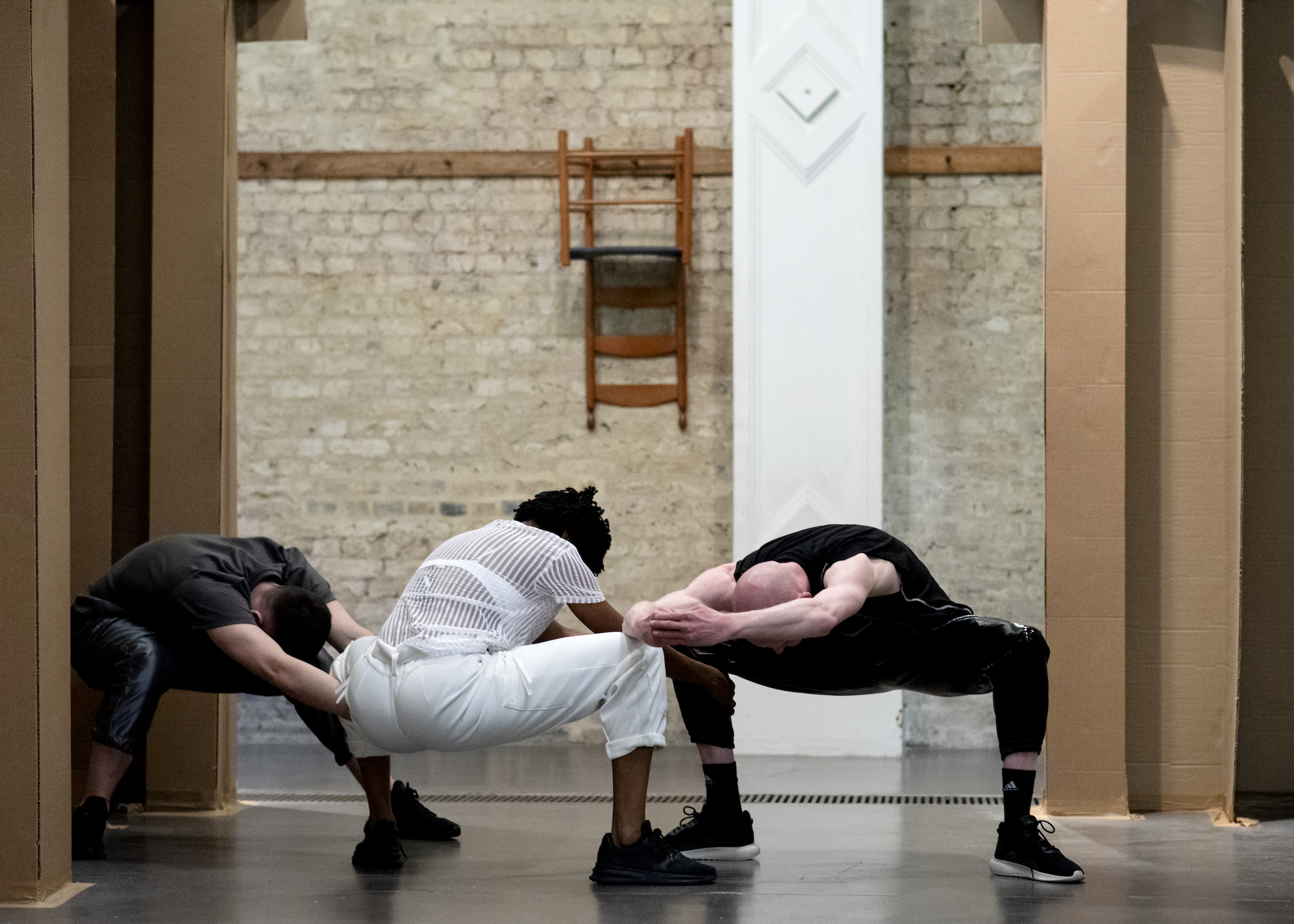 Materiality Will Be Rethought by Joe Moran presented in the exhibition Something Necessary and Useful by Carlos Bunga. Commissioned by Whitechapel Gallery and produced by Dance Art Foundation. Dancers: Temitope Ajose-Cutting, Thomas Heyes and Sean Murray. Photography: Camilla Greenwell.
Materiality Will Be Rethought by Joe Moran presented in the exhibition Something Necessary and Useful by Carlos Bunga. Commissioned by Whitechapel Gallery and produced by Dance Art Foundation. Dancers: Temitope Ajose-Cutting, Thomas Heyes and Sean Murray. Photography: Camilla Greenwell.